Winter Audio Reference: On-Board, Consumer, and Pro Solutions
by Derek Wilson on February 3, 2005 12:05 AM EST- Posted in
- Smartphones
- Mobile
Gaming Performance Tests
As game frame rates in modern systems are not heavily impacted by various audio settings, one of the best measures of "goodness" for games will be simply the maximum number and type of hardware buffers that the card supports. Beyond that, the RightMark 3DSound synthetic test can give an indication of what CPU usage will be like in gaming situations. Listed below are the number and type of hardware buffers that each card supports:
Intel HD Audio: 32 buffers 2D, 3D, EAX 2
Gina3G: 128 buffers 2D only
SoundBlaster Audigy 2 ZS PPro: 62 buffers 2D, 3D, EAX 4 Advanced HD
SoundBlaster Audigy 4 Pro: 62 buffers 2D, 3D, EAX 4 Advanced HD
The fact that the Gina3G can open over twice as many DirectSound buffers as the Audigy gives it an advantage in its ability to push audio. But the target is definitely more of a home studio multi-track editing environment rather than a gaming environment. The Gina3G's lack of any 3D accelerated buffer support does make it less of a gaming audio card, as is to be expected. While the Realtek Intel solution provides EAX 2, it's able to provide adequate support for most games on the market.
There are titles out with support for EAX 3 and 4, and they do sound good. Games like Thief 3 and The Chronicles of Riddick make good use of audio to help the gamer actually play the game. Understanding an environment is becoming truly necessary in modern gaming. But we would prefer to see unique personal innovation or the adoption of open standards rather than consumption of proprietary technology.
The RightMark test simulates some normal positional audio effects and internally checks CPU usage every half second. Overall, CPU usage is averaged together at the end of the run. This is the number that we will look at here. Our graphs are broken into multiple series for 16 and 32 buffers, and we've done graphs for the "no audio" case, simple stereo, hardware 3D, and hardware 3D + EAX. Positional audio, in this case, is done via DirectX.
In our tests, we see the Audigy 2 outperforming the Audigy 4 in our DS3D and EAX tests. The Intel solution puts in a good showing as well, though Creative naturally does EAX better. In the 2D realm, the Gina3G doesn't do too poorly either. Note also, that we are talking about percent CPU usage here, so a score of 0.1 is 0.1% of the CPU. The heaviest hitting test comes in at under 5% CPU usage, which just goes to show how little impact even our least efficient HW 3D + EAX implementation has on overall game performance.
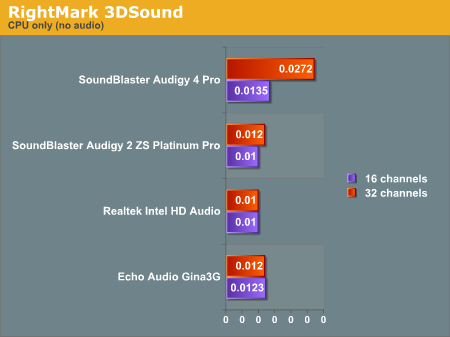
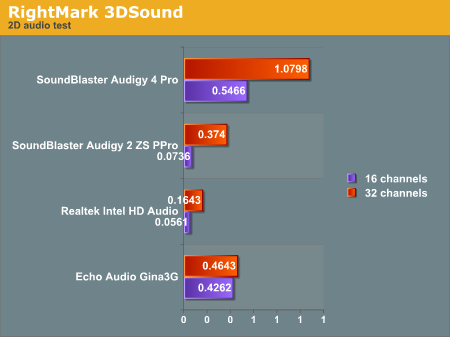
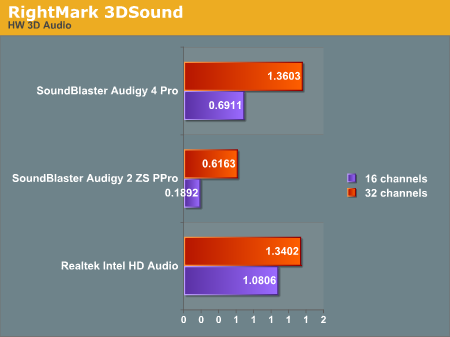
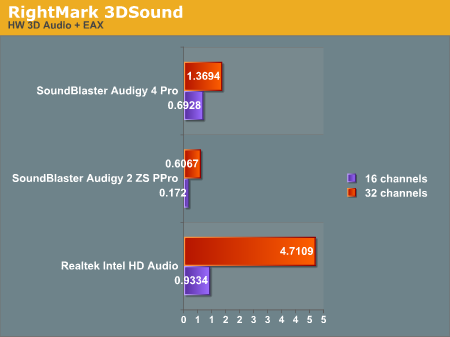
To round out our gaming performance analysis, we'll take a look at Unreal Tournament 2004. All the in-game graphics details were set to "normal" and resolution was set to 800x600. Higher settings pushed the rest of the system too high and drowned out the effect of the audio (as the graphics card became the limiting factor rather than the CPU). Call this artificial if you like, but showing that it takes this much to get a performance delta out of enabling audio is a useful test in and of itself. Especially considering the fact that these differences are bigger than what we saw with Doom 3 no matter what we did.
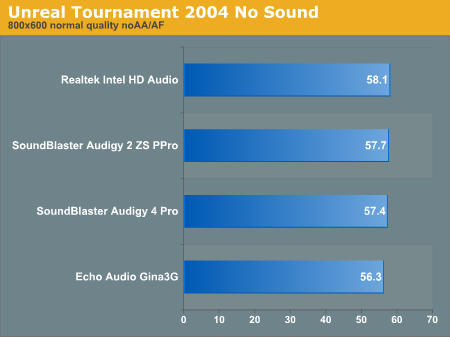
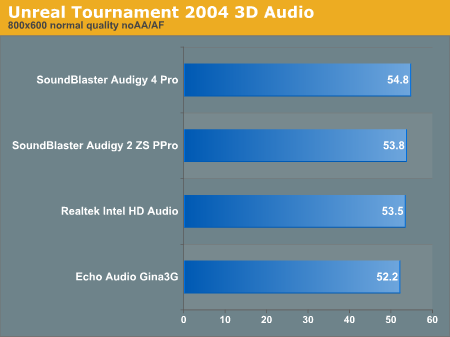
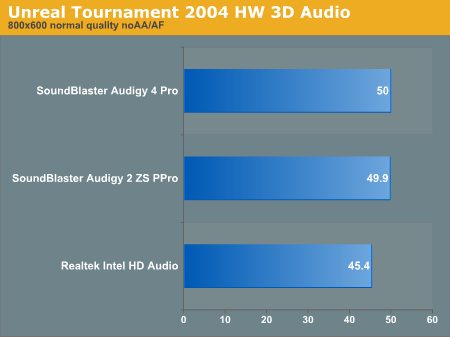
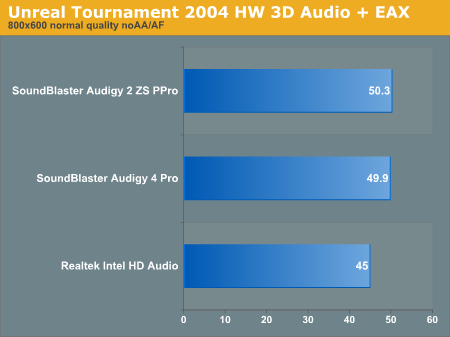










89 Comments
View All Comments
KingofL337 - Friday, February 4, 2005 - link
All, I want is a review of a sound card that does realtime SPDIF DTS/DD encoding not just a card that only does it in DVD's. You find one and I'm gonna go buy it.leliel - Friday, February 4, 2005 - link
i'm still using philips seismic edges (philips tbird avenger chipset, PSC705 model) in my boxen because creative can't put out a decent product. i wouldn't mind seeing the new ultimate edge (PSC724) or aurilium (PSC8xx) reviewed. happy with what i have except the latest drivers for these things are about three years old and games like WoW and republic commando aren't happy with them =PEddNog - Friday, February 4, 2005 - link
MrMarbles; check out the card I have, Echo Audio Mia MIDI. Its sample rate is completely controllable, including full lock to 44.1, with zero resample as long as you bypass Kmixer by either using any of the time critical transports (for example, kernel streaming) or even a special proprietary Kmixer bypass for regular wave audio output that's included in the drivers called Purewave. When I bought it, you could find the card for just $200, and it was over a year ago.-Ed
MrMarbles - Friday, February 4, 2005 - link
I'm interested in buying a soundcard for playing back highquality (if you can call MP3's that) MP3 files. I got an Audigy2 now. Very happy with the low distortion, has a very clean sound on my B&W Nautilus 805 speakers. But, they also have a very wellknown problem with 44.1khz 16bit stereo playback. So looking to upgrade. I'm a bit of a audiophile, but I can't spend too much. Gaming is not something do a lot of anymore.Pandamonium - Friday, February 4, 2005 - link
Missing chipsets:Envy 24HT
nVidia Sounstorm
Maleficus - Thursday, February 3, 2005 - link
THANK YOU, seeing audio on the front page again is AWESOME.LocutusX - Thursday, February 3, 2005 - link
Oh, and the ALC850 is pretty horrible. I used a TB Santa Cruz from 2001 to 2004 (3 years) and noticed the difference straight away when I switched to the on-board sound on my new Athlon64 rig.Later, when I bought an Audigy 2 ZS for Xmas, I noticed the difference on that the moment I popped the card in. Nah, don't waste your time on an ALC850 when there are more worthy things to review;
- VIA Envy24HT cards
- the various Audiophile-ish stuff already mentioned
LocutusX - Thursday, February 3, 2005 - link
From what I've read @ Hydrogenaudio, it's impossible to "bypass" the resample stage with an Audigy 2 ZS (when dealing with 44.1KHz source).Someone posted a wave file which contained a particular sine wave. When played back on hardware which could natively handle 44.1KHz, it sounds fine.
When played back on hardware which resamples 44.1KHz to 48KHz, lots of weird distortion could be heard - sirens, alien noises, etc. On the Audigy 2 ZS, even if you used ASIO or Kernel Streaming output, this behaviour was observed. Only when you did a high quality (SSRC) resample to 48KHz did it sound fine.
BTW I don't see the point in reviewing the TB Santa Cruz. While a good card for its time, that was more than 2 years ago. It's been EOL (end of life) for 2 years now, and there won't be any new drivers made for it. It won't work in future OS's (XP64) and even the most recent XP32 drivers had issues with various games.
vmajor - Thursday, February 3, 2005 - link
Question for Derek, why was Audigy 4 judged better than the Audigy 2? It costs more and was just as bad (or worse)as the Audigy 2 in the objective tests.Regarding the audiophile incursion into Anandtech - just please beware that Audiophilia nervosa is contageous...
...when you start hearing differences between $40 and $4000 cables, power cords, volume knobs (yes, knobs, not pots), 'demagnetised' CDs, etc... take a long holiday.
DerekWilson - Thursday, February 3, 2005 - link
#58, PrinceGaz,Thanks for the feedback. We will explore some of these options.
We did, however, use RightMark 3DSound for our CPU Utilization tests. :-) There wasn't much more detail we could have gone into. We could have reported standard deviation for CPU usage, or even shown the graph over time for each card (which looked roughly the same in every case). The only test we really didn't include there was a test of the maximum number of audio channels on each card, though 32 happened to also be the max channels for the Realtek solution (64 channels for soundblaster 128 channels for gina3g).
There's not much more information that RightMark 3DSound provides than what we showed. Unelss there's something specific you would like us to explore with the program? The effect of custom audio files?